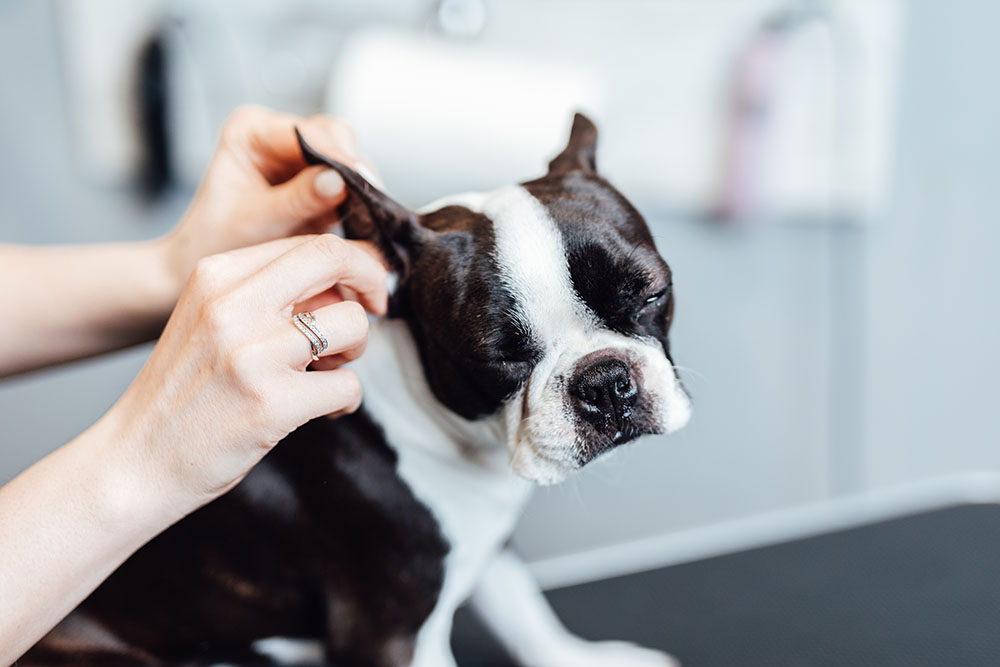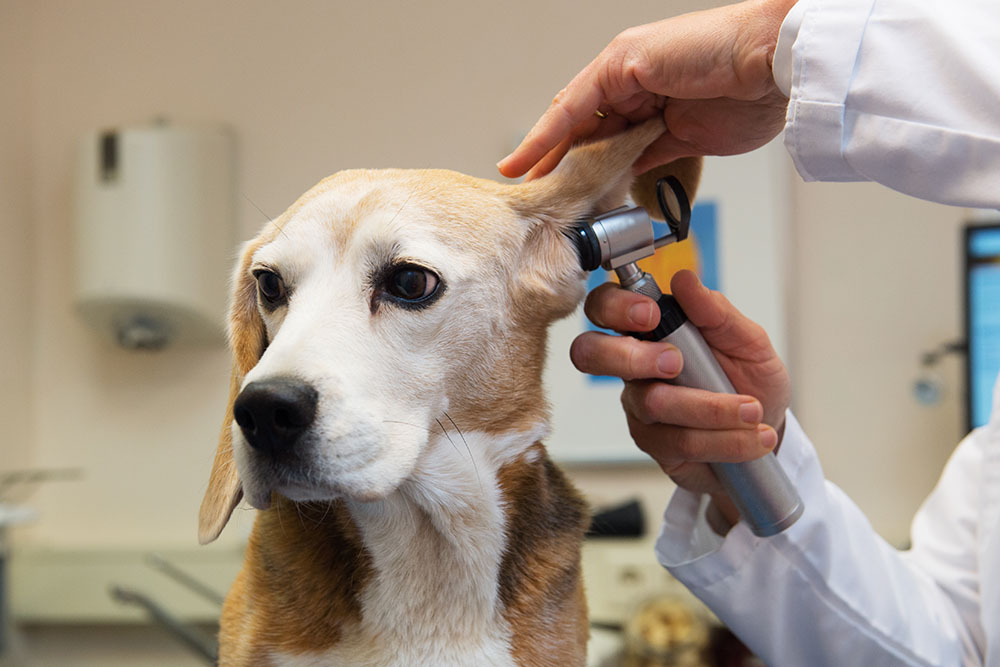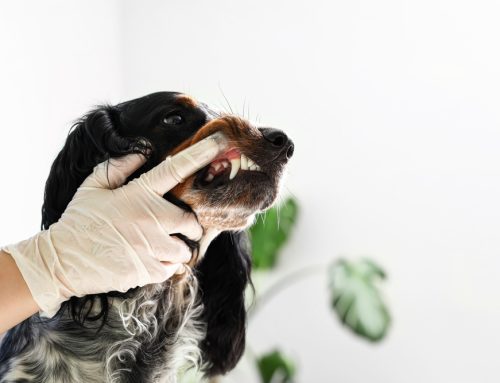Dog Ear Health: When Scratching Signals Something More
Ear scratching, head shaking, or a slight head tilt might seem harmless at first, but in dogs, these subtle signs often point to the start of an ear problem. Left untreated, mild irritation can quickly progress to infection, swelling, and even chronic pain. Recurring issues often have deeper causes, such as allergies, moisture buildup, or structural changes in the ear canal.
At LaGrange Veterinary Hospital in Lagrangeville, NY, we take a thorough, diagnostic approach to dog ear health, identifying the root cause and creating treatment plans that support long-term comfort and wellness.
A Closer Look at Canine Ear Infections
What are Ear Infections?
Ear infections in dogs are more than just uncomfortable scratching sessions. The most common form, otitis externa, affects the outer ear canal and presents with telltale signs like head shaking, foul odor, redness, and discharge.
When left untreated, infections can progress deeper into the middle ear (otitis media) or even reach the inner ear (otitis interna), potentially affecting balance and hearing. Otitis externa in small animals represents one of the most frequent reasons dogs visit veterinary clinics.
Dog ear infection symptoms often start subtly. Your pet might scratch more frequently, shake their head after meals, or develop a slight odor around the ears. As the infection progresses, you may notice thick discharge, swelling that narrows the ear canal, or even behavioral changes as pain increases. Some dogs become head-shy, pulling away when you try to pet them near their ears.
Why Do Dogs Get Ear Infections?
Anything that causes irritation and itching in the ear can cause an ear infection. Damage to the skin barrier of the ear allows the bacteria and yeast in the canal to take over and multiply. The anatomy of a dog’s ear creates the perfect environment for problems to develop. Unlike human ears with straight canals, dogs have L-shaped ear canals that trap moisture and debris. Breeds with floppy ears like Golden Retrievers and Cocker Spaniels face additional challenges because their ear flaps create warm, humid conditions where bacteria and yeast thrive.
Moisture remains the primary culprit behind most ear infections. Swimming, bathing, or even humid weather can leave water trapped in the ear canal. Foreign objects can also lead to serious ear problems, especially during warmer months, when foxtails are prevalent. These barbed grass seeds can travel deep into the ear canal, causing irritation, inflammation, and secondary infections if not promptly removed.
While rare in dogs, parasites like ear mites can also create intense itching that leads to scratching and self-trauma. The resulting wounds become infected, creating a cycle of inflammation and discomfort that can persist for months without proper treatment.
Managing Underlying Conditions
Many dogs with recurring ear infections have underlying allergies that create chronic inflammation. Dog allergies often involve both environmental triggers like pollen and dust mites, and food sensitivities that manifest as ear problems. Identifying and managing these allergies can dramatically reduce infection frequency.
Systemic diseases often manifest as recurring ear infections. Hypothyroidism in dogs reduces immune function and alters skin and ear canal health, making infections more likely. Similarly, Cushing’s disease compromises immune function and creates conditions favorable for bacterial and yeast overgrowth.
Prevention Strategies for Ear Infections
Regular Ear Cleaning
Consistent ear cleaning forms the foundation of ear health, but technique matters more than frequency. Most dogs benefit from weekly cleaning, though some may need more or less depending on their ear shape, activity level, and health status. Cleaning your dog’s ears properly involves applying veterinary-approved ear cleaners, never using cotton swabs, and allowing your dog to shake out loosened debris.
The cleaning process should be gentle and systematic. Fill the ear canal with cleaner, massage the base of the ear for 20-30 seconds, then step back and let your dog shake. Use cotton balls or gauze to wipe away visible debris from the outer ear, but avoid pushing anything deep into the canal where you might pack debris further down.
Nutrition plays a surprisingly important role in dog ear health. Certain nutrients support skin barrier function and reduce inflammation throughout the body, including the ears. Omega-3 fatty acids, zinc, and high-quality proteins all contribute to healthier ear tissue that resists infection. On the flip side, ingredients that your pet is allergic or sensitive to will increase inflammation, leading to itching and potentially infection.
Regular Veterinary Check-Ups
Routine veterinary examinations catch ear problems before they become painful infections. During wellness visits at LaGrange Veterinary Hospital, veterinarians use otoscopes to examine deep into the ear canal, checking for early signs of inflammation, excess wax production, or structural abnormalities that predispose dogs to infections.
Early detection allows for preventive treatments that stop minor irritations from developing into full-blown infections. Your veterinarian can also identify underlying conditions like allergies or hormonal imbalances that contribute to recurring ear problems.
Treatment Options for Ear Infections in Dogs
Getting your pet’s ear problem properly diagnosed is the first step toward real relief. During your visit, your veterinarian will often perform an ear cytology– a quick, painless test that looks at a sample from the ear under the microscope. This helps identify whether bacteria, yeast, or other organisms are causing the infection so treatment can be tailored specifically to what’s found, rather than relying on guesswork.
If your pet has a chronic or hard-to-treat infection, your vet may recommend a culture and sensitivity test. This test grows the bacteria from the ear and determines exactly which antibiotics will work best to clear it up. By combining the results of cytology and culture testing, your veterinarian can choose the most effective treatment plan- helping your pet heal faster and stay comfortable longer.
When Ear Infections in Dogs Persist
Chronic ear infections often indicate underlying problems that haven’t been addressed.
Persistent infections can also lead to hearing loss, balance problems, and chronic pain that affects quality of life. These complications emphasize the importance of thorough diagnostic workups to identify root causes rather than just treating symptoms.
Medications and Topical Treatments
Treating ear infections requires the right medication applied correctly. Most infections respond well to topical treatments that combine antibiotics, antifungals, and anti-inflammatory medications. However, examining and medicating the ears of a dog requires patience and proper technique to ensure medications reach infected areas.
The key to successful treatment lies in thorough ear cleaning before medication application. Debris and discharge prevent medications from contacting infected tissue, reducing treatment effectiveness. Many treatment failures result from inadequate cleaning rather than antibiotic resistance.
Surgical Options
When conservative treatments fail or infections cause permanent changes to ear canal structure, surgery may be necessary. Total ear canal ablation (TECA) in dogs represents the most definitive surgical treatment for end-stage ear disease. While this procedure eliminates the infected ear canal entirely, it also removes hearing in that ear.
Surgery becomes an option when chronic infections cause calcification of ear canal cartilage, making medical management impossible. These cases often involve years of recurring infections that have permanently damaged ear tissue.
Some dogs develop an ear hematoma from vigorous head shaking, creating blood-filled swellings in the ear flap that require surgical drainage.
Alternative and Integrative Therapies
Many dogs benefit from combining conventional treatments with alternative therapies. LaGrange Veterinary Hospital services include acupuncture and homeopathic treatments that can reduce inflammation and support the immune system’s ability to fight infections naturally.
Integrative approaches work particularly well for dogs with chronic ear problems related to allergies or immune system dysfunction. These therapies don’t replace conventional treatments but can enhance healing and reduce the frequency of recurring infections.
Treatment Myths and Misconceptions
Many pet owners believe that ear infections will resolve on their own or that over-the-counter treatments provide adequate care. While minor irritations might improve without intervention, true bacterial or yeast infections require prescription medications to clear completely.
Another common misconception involves using home remedies like vinegar or hydrogen peroxide for cleaning. These substances can actually worsen infections by altering the ear’s natural pH balance or causing chemical burns to inflamed tissue.
Your Dog’s Path to Healthy Ears Starts at LaGrange Veterinary Hospital
Preventing ear infections requires consistent care, early intervention, and addressing underlying causes rather than just treating symptoms. Regular cleaning, managing allergies, and maintaining routine veterinary care create the best foundation for long-term ear health.
If you notice head shaking, ear odor, discharge, or scratching that seems more intense than usual, these signs warrant prompt veterinary attention from our team. LaGrange Veterinary Hospital offers comprehensive diagnostic services and treatment options that address both immediate infections and underlying causes. Schedule an appointment by calling (845) 473-9121 or request an appointment online to give your dog the specialized care they deserve.









Leave A Comment